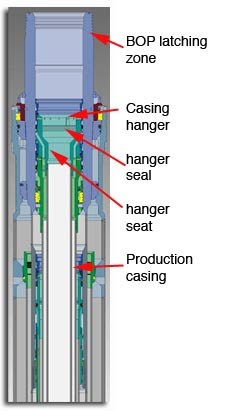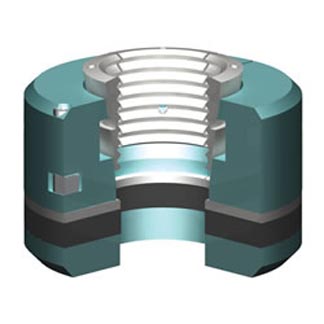
Posted on 09/13/2010 11:59:09 AM PDT by Ernest_at_the_Beach
A short time ago I wrote about the concerns with the casing hanger in the Deepwater Horizon well, and the risk that it might lift and allow whatever fluid is in the annulus between the production casing and the well lining to be released. In his remarks on Friday Admiral Allen discussed that situation. At some point there has to be a seal on the top of the well to prevent fluid escaping from the annulus. The solution that he, the science team, and BP have reached is that the casing hanger will be locked into place, so that it cannot lift off the seat. This was the illustration that I used back then:

With the casing hanger itself looking like this:

The lack of a locking ring was a bit of a bone of contention when the initial Congressional hearings took place back in June, being one of the five issues that Congressman Waxman brought up in a letter to Tony Hayward. (The other four were the design of the well itself; the “centralizer” issue; the failure to run a bond log; and the failure to circulate possible gas-bearing mud out of the well. ) It may not have been necessary back when the well first started to flow (if the annulus is, in fact, still full of mud rather than oil) and the seal is currently working, but by putting a lock on the casing hanger so that it cannot rise out of the seat they are ensuring that it will not move, even if pressure increases in the annulus, after the relief well makes contact. Locking it can be carried out by running a string of drill pipe down to engage the top threads of the hanger, so that it can’t move. Alternatively it can be connected to the surrounding wellhead structure, perhaps by running a sleeve back up to the overlying BOP. It could have been locked with special locking screws that ran through the wellhead, but they aren't in play at this point.
Admiral Allen noted:
In essence, we're going to put a ring or what they call a sleeve around the top that'll lock that casing hanger in place, will not allow it to move. There is always concern that when we pressurize the annulus, that casing hanger would lift, allow free communication between the annulus up into the blowout preventer.
Cement in the annulus will be one way to preclude that from happening. But after some consultation and looking at various alternatives, the BP engineers and our science team agreed that if we could ascertain that the casing hanger had not been dislodged, in other words, where we need it to be, then we could actually put a sleeve around it and basically lock it down.
And the order that I issued to BP, I ordered them to take what are called lead impressions. You go down, you take an impression of the top of the casing hanger. And then that allows you to take measurements on where its location is. Based on that measurement that they took, it appears that the casing hanger has not been dislodged to the point where we'd have a problem with the seal, so we just need to lock it in place, and that would substitute for the pressure control that cementing the annulus would have provided.
Once BP tells the Admiral how long it is going to take to lock the hanger down, and it is done, then he will give permission to restart the relief well. The impressions of the seat were apparently made by lowering lead blocks onto the hanger and deforming them. This provided the required impression of the position of the top of the hanger, from which it was possible to decide that it hadn’t moved.
With that seal in place it is no longer necessary, at this time, to perforate the top of the casing to insert a cement plug, since the seal will itself provide a plug during the relief well operations. (The plug will still be needed for the abandonment part of the process).
MoonofA has illustrated the process that is now to be followed in complying with the Admiral’s instructions. I am copying the comments that go with two of the illustrations from that comment:
(This) picture shows what will happen in the next days.
1. The casing hanger lockdown sleeve will get installed (not shown).
2. Developer Driller II above the original Macondo well will put its drill pipe into the hole and will perforate the production liner long string just above the top-kill cement. (If the annular is pressurized from the reservoir it may take a kick doing this.)
Pumping cement into the annular in this state would be dangerous and difficult as whatever is in there now, mud or oil, has no place to go. To avoid any damage when pushing cement down in there we need some communication to be able to retrieve the stuff that the cement will replace.Therefore:
3. Developer Driller III doing the relief well will intersect below the outer casing into the annular between the long string and the well bore. This will then form a U-tube between the DDII down through the annular between the long string and the outer casing and up to the DDIII. Mud can then be pumped from one rig down the hole up to the other rig to test the communication through the annular.
4. Fresh cement (green) will then be pumped from the DDII down its drill pipe into the annular. As communication is established, whatever is then in the annular, mud or oil, can be pushed by the cement up to the DDIII.
With this the annular is then truly dead and The Admiral’s point 5 demand will be fulfilled.
However, to get the perforations just above the cement, the perforating tool has to reach that position, which it can only do if there is no old drill pipe in the way. We will see if any is found, and they fish for it.
Terry Hazen on bacteria eating Gulf oil spill plume
***********************************EXCERPT*******************************************
Back in the lab, said Hazen, cloned samples of the newly discovered bacteria appear to be able to digest a quantity of oil half volume of the Gulf oil plume about every three days. They eventually break the oil down to CO2 and water, he said.
Oil spill science: Shallower plume found at Deepwater Horizon site - September 12, 2010
*********************************EXCERPT******************************************
posted by tinys_alabama on September 13, 2010 - 2:17pm
Excerpt:
Earlier in the week, the Cape Hatteras collected samples to the west of the main plume, which runs southwest from the well site at about 1,200 meters. A number of research cruises have been collecting data on this plume, which the US National Oceanic and Atmospheric Administration (NOAA) is aggregating onto one grid. But on Thursday last week, the R/V Oceanus, conducting research under the same National Science Foundation (NSF) grant as the Hatteras, reported lower beam transmission, a data signal indicative of increased methane levels and the presence of hydrocarbons, between 200 and 300 meters. The Hatteras steamed more than 10 hours back to where these readings were taken, in the vicinity of the well site, to investigate further. "While I would like to have found the western edge of the main plume we've all been mapping," chief scientist Tracy Villareal said, "this new development was way too exciting not to pursue.”
http://blogs.nature.com/news/thegreatbeyond/2010/09/oil_spill_science_sh...
CO2? OMG we are all goona die!!!! /s
Right,...Government Research Funds reports that always seem to report more CO2 coming.
Yet another totally useless comment from the so-called scientists on the vessels. Not a quantitative figure found in the entire piece. I’m sorry, but “...100 times background...” is NOT a unit of measurement. WHAT WAS THE MEASURED CONCENTRATION!!!!!
Couple more weeks and 235 is history.
We need to develop a bunker buster ground penetrating missle equiped with a warhead loaded with this bacteria.
Imagine the consequences if all of the Moslem's oil being eaten by this bacteria! Then what do they have to offer the world? Dates? Camel Spit? All funding for Global Jihad will cease.
Nobel Peace Prize? COME TO PAPA!
I have to say that I am impressed with what these people know.
What I get the impression that happened, the people in charge were under too much pressure to get the well up and running. Their shortcuts killed them.
Sad.
Paul
Disclaimer: Opinions posted on Free Republic are those of the individual posters and do not necessarily represent the opinion of Free Republic or its management. All materials posted herein are protected by copyright law and the exemption for fair use of copyrighted works.